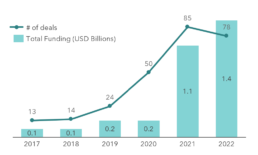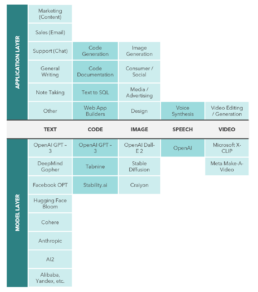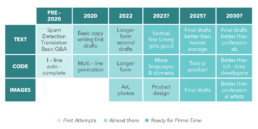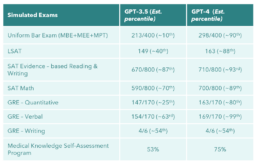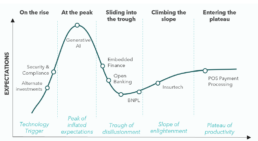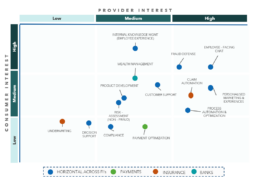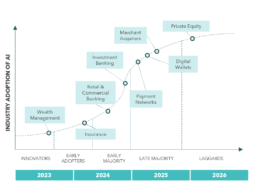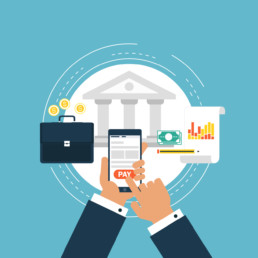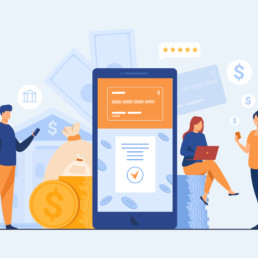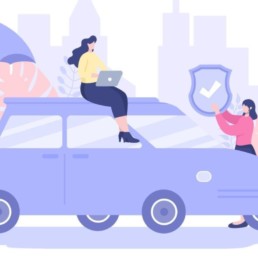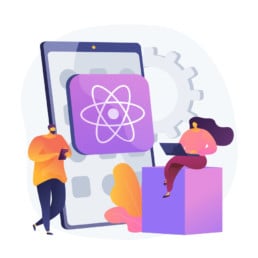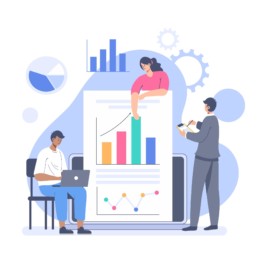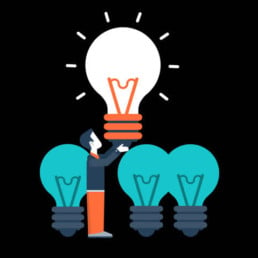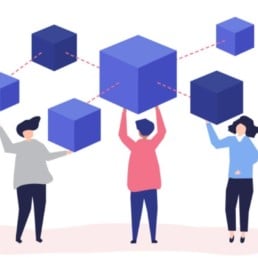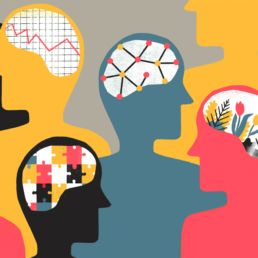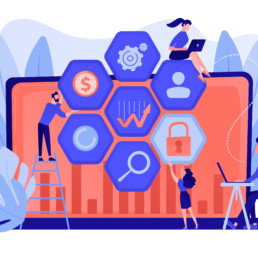Prologue
Stripe recently announced the integration of OpenAI’s ChatGPT-4(1). As per Stripe, there are at least 14 prototypes of this multi-modal generative AI model at work at Stripe. In another use case, Morgan Stanley is experimenting with GPT-4 for its wealth management personnel to retrieve actionable information from its extensive content library (2). GPT–4 will power an internal chatbot, streamlining the search process and providing instant access to expert insights. Furthermore, in a survey by Fishbowl (a social media platform owned by Glassdoor), almost 30% of the work professionals said that they’ve used Open AI’s ChatGPT(3) or another AI program for their work. The sample set included employees from firms such as Bank of America and JP Morgan. A Stanford economist opined that Chat GPT could become the ‘calculator of writing’ augmenting the ability of professionals to write and thus enhance productivity(4).
The Acceleration of Generative AI?
Generative AI, in its simplest form is a derivative of artificial intelligence that creates content (images, music, text, videos) with simple prompts, contexts and conditions. There are multiple generative AI models for use e.g., Open AI DALL E-2 that can produce images and has over 3 million users creating 4 million images per day. Meta and Google have their own versions of generative AI products such as Make-a-video and MusicLM that can create text to video and music, respectively. According to Financial Times, already over $2B has been invested in Generative AI up 425% since 2020(5) and by 2025, Gartner expects generative AI to account for 10% of all data produced, up from less than 1% today(6)
Exhibit 1. US Venture Capital Investment in Generative AI, 2017–227
Exhibit 2. Generative AI Application Landscape(8)
As widely known by now, Chat GPT (Generative Pretrained transformer) is a conversational generative AI model that can generate human-like text based on the input provided to it and perform a variety of tasks such as, answering questions, generating text (e.g., summaries, story generation), translating text, and chatting in a conversational manner.
Beyond the mentioned examples, the internet is already a flood with ChatGPT creative responses to abstract prompts and even poetry, music lyrics generated from it. Despite its limitation, as generative AI models have their own biases, requirement of immense computational powers, accuracy, explicability of information produced, and even timeliness of data on which it is trained, CEOs remain bullish on its possibilities and term it as revolutionary(9).
Exhibit 3. Generative AI Maturity Curve(10)
GPT–4 which presents a further exciting frontier for generative AI use – cases across industries is a large multimodal model which can accept images and text inputs and generate text outputs. GPT–4, though less capable than humans in many scenarios has been able to demonstrate human–level performance on various academic and professional benchmarks. It scored better on LSAT than 88% of people who took at that test and passed the simulated bar exam being in the top 10% of exam–takers showing exemplary improvement compared to GPT–3.5 that scored around bottom 10%(11).
Exhibit 4. Rapid improvement in GPT–4 performance (11)
Impact on Financial Services
Generative AI has begun changing workflows in the knowledge economy with copywriters, designers, coders, photo, and video editors and even strategists using it to generate and brainstorm more ideas, simplify their search responses to more coherent outputs, converse with customers, assist in coding by co-writing codes, etc. All the above will have strongly intertwined implications for the financial services industry for both incumbents and Fintechs. The Dealroom Fintech 2022 report highlights a gallimaufry of Generative AI use cases within the fintech industry (12). Generative AI technology is expected to enhance chatbots for financial institutions, particularly within wealth management.
Exhibit 5. Fintech VC Hype Cycle (12)
We believe ChatGPT or Generative AI use cases will touch all aspects of the financial services lifecycle i.e., Distribution (how the product is sold to customers), Manufacturing (how the product is designed), and Servicing (how the product is delivered and serviced for the
customers) 13.
- Customer Experience. Generative AI can be used to automate routine tasks, such as customer service, fraud detection, and payment processing. This can free up human employees to focus on higher-value tasks, improve response times, and provide a better customer experience.
- Personalized Marketing. large customer data sets can be analyzed, and surveys can then be run to recommend targeted products and offers. This can easily yield higher sales conversion rates, boosting engagement and customer experience
- Automation of Repetitive Tasks. Generative AI can be used to automate manual and time-consuming tasks, such as reconciliation, document generation, and analytics. This can increase efficiency and reduce errors, freeing up resources and improving profitability. The technology can help verify documents written in natural language and identify efficient payment methods or processing routes. For customers, this means accelerated payment or claims processing; for providers, improved cost-effectiveness.
- Decision Support. Generative AI can be used to analyze large amounts of data and generate insights to inform business decisions. This can improve the accuracy and speed of decision-making, and lead to better business outcomes.
- Fraud Detection and Prevention. Generative AI can be used to create training data sets for fraud detection models to make them better and augment their capability to identify suspicious and illegitimate transactions. It will lead to limiting false positives and enhancing fraud detection capability.
- Client Support Training and Enhancement. Though generative AI conversational bots can be put for directly handling client queries including complex queries but that will lead continuous inspection by warm bodies about biases, wrong results, etc. Augmenting client support agents through faster prompts from within the library of internal knowledge will be an immediate and desirable use – case.
- Product Development. Generative AI can analyze large sets of data to produce insights into emerging trends across customer segments. It can lead to designing products to meet the evolving customer needs where again generative AI can be put to use to write the basic code, creating test scenarios, writing product roadmaps and even developing wire-frames for the product.
Within financial services Generative AI is going to have a strong anchoring impact on customer service, and decisions on lending, fraud, and money laundering. Additionally, there will be several employee facing use case to enhance internal knowledge management and productivity.
Exhibit 6. Interest in Generative AI use cases across financial services (14)
Client Support is Going to Get a Spry Look
With a long hype of chatbots or conversation AI bots being the disruptor in consumer services, especially in banking, ChatGPT might deliver the intelligent digital assistants needed to understand complex queries and produce coherent and intelligent responses.
With further improvements in NLP, speech recognition, and NLG capabilities, intelligent digital assistants will become core to proactive and reactive customer engagement for banks and payment firms. AI has already shown its effectiveness in banking through Bank of America’s wildly popular chatbot Erica which hit 1 Billion client interactions by Oct-2022 hitting nearly 1.5M a day (15).
Use cases getting a significant pump up from generative AI will include:
- 24/7 Customer Support Bot. As per the Zendesk customer experience survey, almost half of the customers prefer having a real–time 24/7 support for their queries16 and around 75% prefer self–service to resolve their queries. With interactive conversational AI capabilities trained on the right data sets, banks and financial service players can cater to their global customers in real time without ramping up their customer support teams’ costs.
- Knowledge Search. Support teams typically struggle with navigating tons of files and documents while resolving customer queries. With Generative AI tools, customer support teams could easily navigate through internal knowledge and get quicker coherent responses and links to relevant files to customer queries. Goodbye inaccessible tribal knowledge!
All the above will increase employee engagement within the client support teams that are strained by large volumes of queries. Additionally, it will enhance the customer experience with timely resolution and intelligent conversations.
-
Augment employee engagement. With generative AI sifting through volumes of FAQs, and manuals for a required product and service, it can augment the client support executives by identifying knowledge gaps, creating manuals and FAQs, navigating to right sources of knowledge and create an interactive learning environment for client support agents.
All the above will increase employee engagement within the client support teams that are strained by large volumes of queries. Additionally, it will enhance the customer experience with timely resolution and intelligent conversations.
Some Caution is Warranted
The frenzy of ChatGPT has put generative AI on a pedestal but its nascency and limitations warrant caution. Some of the challenges include:
- Explicability of its results. The black-box nature of Generative AI models makes it hard to validate the accuracy and fairness of the model’s decisions. The highly advanced nature of the models and large amounts of data, make it challenging to diagnose how the model arrived at its conclusions.
- Bias in data. Generative AI models are trained on large amounts of data, and if that data contains biases, the model will likely perpetuate those biases.
- Lack of control. These models can generate unexpected results that may not align with the purpose and values of the organization – and companies will need to adapt the technology to incorporate their culture and values, an exercise that requires technical expertise and computing power beyond what some companies may have ready access to.
- Difficulty in modifying. Given the complexity of these models, it can be difficult to alter their behavior or correct errors in their results.
- Intellectual-property. Several questions are yet to be answered e.g., When a generative AI model brings forward a new product design or idea based on a user prompt, who can lay claim to it? What happens when it plagiarizes a source based on its training data?
Organizations will need to increase the transparency and interpretability of their models to ensure that they are being used ethically and effectively. This will need customizations, technological capabilities, and investments to craft models suited to their needs.
Breaking The Innovations Staid ...
ChatGPT can already analyze all open-source code and synthesize code libraries to help create code capsules. It could lead to true rapid prototyping, with warm body developers supplementing it with more complex/nuanced features. With iterative learning, the AI could become better at generating the code and product development ideas such as writing the product features, preliminary code for the development and creating test environment for the product features.
GPT–4 is also a great tool for de-bugging code and offering potential fixes. This feature, if implemented into development environments, could rapidly improve code quality and reduce time-to-market.
Fraud prevention is also likely to receive a boost from Generative AI. Models could be trained in large sets of historic payment information, allowing it to learn how individual cards are usually used, as well as providing analysts with a view of current fraud trends. It can then help fraud analysts by filtering away low-likelihood fraud alerts, reducing manual review efforts.
Finally, ChatGPT generative capabilities might be used by executives in supporting their decision-making. They can start using Generative AI tools to synthesize supporting evidence for decision support and maintaining an audit trail.
How Should One Prepare?
Generative AI’s rise has been steep; however, the adoption of its disruptive potential is going to be gradual due to regulations and difficulty to unwind expensive mistakes. Regardless, there is little time to prepare. We recommend firms:
- Educate employees on Generative AI uses and limitations: Relevant stakeholders should be given access to ChatGPT to keep experimenting and explore its capabilities as well as limitations.
- Start fleshing out and testing new use cases. Start framing and testing low risk internal employee facing use cases with the target audience. The success of these initial use cases will determine further customer facing uses and help in mitigating risks and limitations such as biased output, factual errors, etc.
- Develop a Generative AI strategy and roadmap. Start putting a generative AI strategy and integration plan including governance and change management templates, plans and policies in place to ensure faster integration of generative AI within the organization for both internal and external use cases.
Exhibit 7. Innovation Adoption Curve for FIs (17)
In Closing..
The arms race triggered by ChatGPT is undoubtedly going to be beneficial for this emerging technology as it is likely to have many tangible real-life applications. It is going to usher in quick applications in client service and support and enhance the productivity of employees and developers in financial services. To conclude, if one asks ChatGPT how transformative it can be for the industries and financial services, it utters quite confidently,.
“By enabling the automation of many tasks that were previously done by humans, generative AI has the potential to increase efficiency and productivity, reduce costs, and open new opportunities for growth. Overall, generative AI has the potential to greatly improve efficiency and create significant competitive advantages for financial institutions”
– ChatGPT
__________________________________________________________________________________________________________
- FreeThink
- The Fintech Times
- Time
- Market Scale
- Forbes
- Gartner
- Pitchbook
- Sequoia Blog
- The Economic Times
- Sequoia Blog
- OpenAI Blog
- Dealroom Fintech
- Bain Capital Ventures Blog on Generative AI
- Insider Intelligence Report on Generative AI impact on Financial Services
- PYMNTS
- Zendesk
- Insider Intelligence Report on Generative AI impact on financial services
